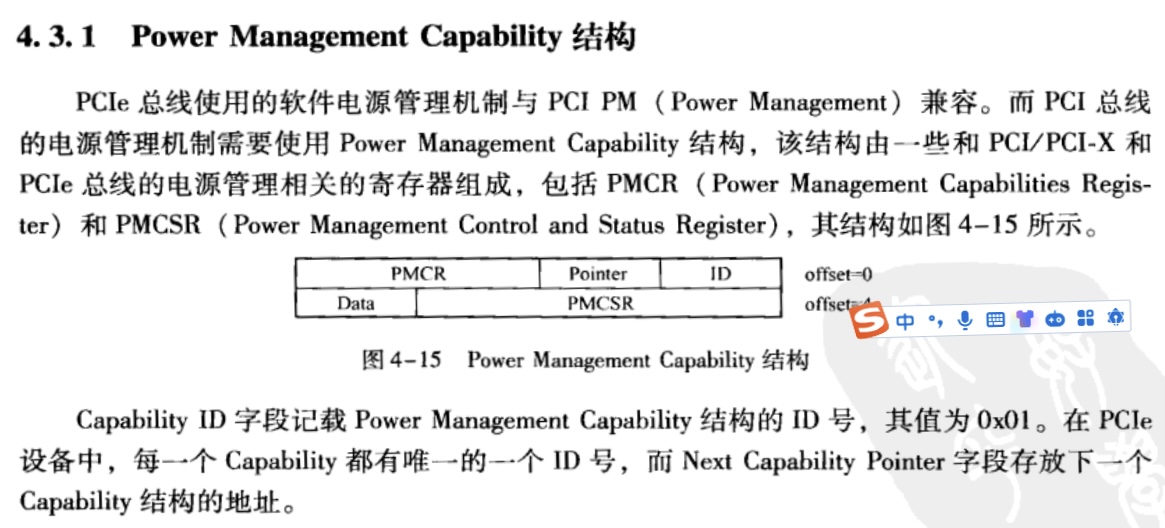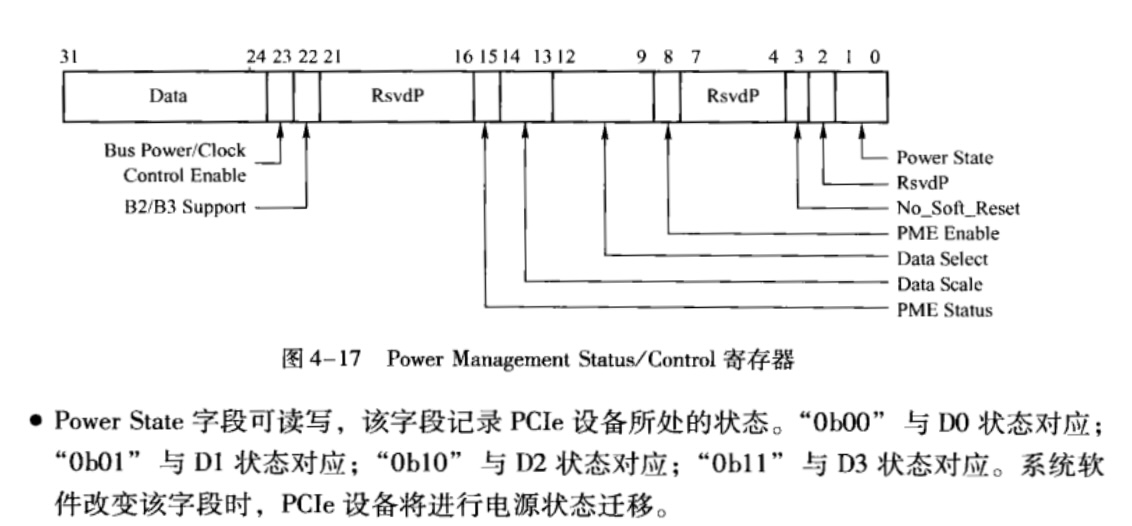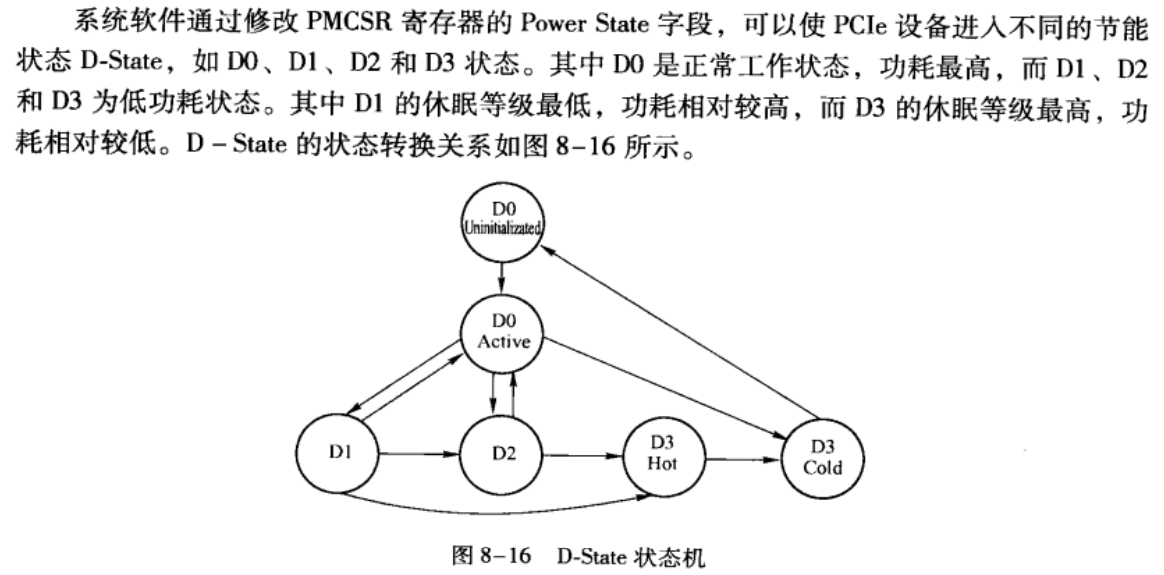pci_enable_device()
前言
在 PCI 总线下,当 PCIe 设备和 PCIe 驱动匹配后,就会执行驱动的 probe() 函数来初始化设备,以让设备正常运行。
在 probe() 函数中,最先做的事情就是执行 pci_enable_device() 来使能设备。如果设备都无法使能的话,那就直接返回,接下来的工作也就不用做了。
代码解析
pci_enable_device() 的实现在内核 pci 子系统中,所在文件为 drivers/pci/pci.c
/**
* pci_enable_device - Initialize device before it's used by a driver.
* @dev: PCI device to be initialized
*
* Initialize device before it's used by a driver. Ask low-level code
* to enable I/O and memory. Wake up the device if it was suspended.
* Beware, this function can fail.
*
* Note we don't actually enable the device many times if we call
* this function repeatedly (we just increment the count).
*/
int pci_enable_device(struct pci_dev *dev)
{
return pci_enable_device_flags(dev, IORESOURCE_MEM | IORESOURCE_IO);
}
在 pci_enable_device() 中调用 pci_enable_device_flags(),pci_enable_device_flags() 实现如下
static int pci_enable_device_flags(struct pci_dev *dev, unsigned long flags)
{
struct pci_dev *bridge;
int err;
int i, bars = 0;
/*
* Power state could be unknown at this point, either due to a fresh
* boot or a device removal call. So get the current power state
* so that things like MSI message writing will behave as expected
* (e.g. if the device really is in D0 at enable time).
*/
if (dev->pm_cap) {
u16 pmcsr;
pci_read_config_word(dev, dev->pm_cap + PCI_PM_CTRL, &pmcsr);
dev->current_state = (pmcsr & PCI_PM_CTRL_STATE_MASK);
}
if (atomic_inc_return(&dev->enable_cnt) > 1)
return 0; /* already enabled */
bridge = pci_upstream_bridge(dev);
if (bridge)
pci_enable_bridge(bridge);
/* only skip sriov related */
for (i = 0; i <= PCI_ROM_RESOURCE; i++)
if (dev->resource[i].flags & flags)
bars |= (1 << i);
for (i = PCI_BRIDGE_RESOURCES; i < DEVICE_COUNT_RESOURCE; i++)
if (dev->resource[i].flags & flags)
bars |= (1 << i);
err = do_pci_enable_device(dev, bars);
if (err < 0)
atomic_dec(&dev->enable_cnt);
return err;
}
第 15 行调用 pci_read_config_word(dev, dev->pm_cap + PCI_PM_CTRL, &pmcsr); 读取电源管理寄存器(起始地址:0x40)的 PMCSR 字段(地址:0x40 + 4),该字段占 3 个字节,但最高 1 字节为保留位,所以有效字节为 2 字节。所以代码中使用 u16 类型的变量 pmcsr 来存储读到的值。
在这里插一句:
PCI 设备使用的基本配置空间由 64 个字节组成,地址范围为 0x00 ~ 0x3F,这 64 个字节是所有 PCI 设备必须支持的。事实上,许多 PCI 设备也仅支持这 64 个配置寄存器。
此外,PCIe 设备还扩展了 0x40 ~ 0xFF 这段配置空间,这段配置空间主要存放一些与 MSI 中断机制和电源管理相关的 Capability 结构。
以下是《PCI EXPRESS 体系结构导读》中对电源管理寄存器的介绍


从规范中可以看到,PMCSR 的第 0~1 bits 为 Power State 字段,所以代码中该字段的掩码为 0x3。
pmcsr 与掩码按位与就得到了 Power State,将结果赋值给 dev->current_state。
#define PCI_PM_CTRL_STATE_MASK 0x0003 /* Current power state (D0 to D3) */
dev->current_state = (pmcsr & PCI_PM_CTRL_STATE_MASK);
下面这两行代码应验了 pci_enable_device() 函数的注释: we don’t actually enable the device many times if we call this function repeatedly (we just increment the count).
if (atomic_inc_return(&dev->enable_cnt) > 1)
return 0; /* already enabled */
接下来的三行代码,作用是,使能该 PCIe 设备的上游桥片,upstream 这个概念也是 PCI 规范中出现的。
使能上游桥片,想想也是理所当然,如果上游桥片不工作,那么处于该桥片下面的设备怎么可能正常工作呢。
bridge = pci_upstream_bridge(dev);
if (bridge)
pci_enable_bridge(bridge);
接着获取 bar 掩码,表示使用了哪几个 BAR,对于 PCIe 设备而言,最多有 6 个 BAR 空间,即 BAR0~BAR5。
/* only skip sriov related */
for (i = 0; i <= PCI_ROM_RESOURCE; i++)
if (dev->resource[i].flags & flags)
bars |= (1 << i);
for (i = PCI_BRIDGE_RESOURCES; i < DEVICE_COUNT_RESOURCE; i++)
if (dev->resource[i].flags & flags)
bars |= (1 << i);
接着就到了 do_pci_enable_device(dev, bars),看下 do_pci_enable_device() 的具体实现
static int do_pci_enable_device(struct pci_dev *dev, int bars)
{
int err;
struct pci_dev *bridge;
u16 cmd;
u8 pin;
err = pci_set_power_state(dev, PCI_D0);
if (err < 0 && err != -EIO)
return err;
bridge = pci_upstream_bridge(dev);
if (bridge)
pcie_aspm_powersave_config_link(bridge);
err = pcibios_enable_device(dev, bars);
if (err < 0)
return err;
pci_fixup_device(pci_fixup_enable, dev);
if (dev->msi_enabled || dev->msix_enabled)
return 0;
pci_read_config_byte(dev, PCI_INTERRUPT_PIN, &pin);
if (pin) {
pci_read_config_word(dev, PCI_COMMAND, &cmd);
if (cmd & PCI_COMMAND_INTX_DISABLE)
pci_write_config_word(dev, PCI_COMMAND,
cmd & ~PCI_COMMAND_INTX_DISABLE);
}
return 0;
}
第 8 行 pci_set_power_state(dev, PCI_D0) 将设备设置为 D0 状态,
pci_set_power_state() 具体实现如下
/**
* pci_set_power_state - Set the power state of a PCI device
* @dev: PCI device to handle.
* @state: PCI power state (D0, D1, D2, D3hot) to put the device into.
*
* Transition a device to a new power state, using the platform firmware and/or
* the device's PCI PM registers.
*
* RETURN VALUE:
* -EINVAL if the requested state is invalid.
* -EIO if device does not support PCI PM or its PM capabilities register has a
* wrong version, or device doesn't support the requested state.
* 0 if the transition is to D1 or D2 but D1 and D2 are not supported.
* 0 if device already is in the requested state.
* 0 if the transition is to D3 but D3 is not supported.
* 0 if device's power state has been successfully changed.
*/
int pci_set_power_state(struct pci_dev *dev, pci_power_t state)
{
int error;
/* bound the state we're entering */
if (state > PCI_D3cold)
state = PCI_D3cold;
else if (state < PCI_D0)
state = PCI_D0;
else if ((state == PCI_D1 || state == PCI_D2) && pci_no_d1d2(dev))
/*
* If the device or the parent bridge do not support PCI PM,
* ignore the request if we're doing anything other than putting
* it into D0 (which would only happen on boot).
*/
return 0;
/* Check if we're already there */
if (dev->current_state == state)
return 0;
__pci_start_power_transition(dev, state);
/* This device is quirked not to be put into D3, so
don't put it in D3 */
if (state >= PCI_D3hot && (dev->dev_flags & PCI_DEV_FLAGS_NO_D3))
return 0;
/*
* To put device in D3cold, we put device into D3hot in native
* way, then put device into D3cold with platform ops
*/
error = pci_raw_set_power_state(dev, state > PCI_D3hot ?
PCI_D3hot : state);
if (!__pci_complete_power_transition(dev, state))
error = 0;
return error;
}
其中 D0、D1、D2、D3cold、D3hot 状态及其转换关系在 PCIe 规范中都有明确规定,

该段代码调用 pci_raw_set_power_state(dev, state > PCI_D3hot ? PCI_D3hot : state); 将 PCIe 设备设置为 D0 状态,pci_raw_set_power_state() 函数的实现如下,
/**
* pci_raw_set_power_state - Use PCI PM registers to set the power state of
* given PCI device
* @dev: PCI device to handle.
* @state: PCI power state (D0, D1, D2, D3hot) to put the device into.
*
* RETURN VALUE:
* -EINVAL if the requested state is invalid.
* -EIO if device does not support PCI PM or its PM capabilities register has a
* wrong version, or device doesn't support the requested state.
* 0 if device already is in the requested state.
* 0 if device's power state has been successfully changed.
*/
static int pci_raw_set_power_state(struct pci_dev *dev, pci_power_t state)
{
u16 pmcsr;
bool need_restore = false;
/* Check if we're already there */
if (dev->current_state == state)
return 0;
if (!dev->pm_cap)
return -EIO;
if (state < PCI_D0 || state > PCI_D3hot)
return -EINVAL;
/* Validate current state:
* Can enter D0 from any state, but if we can only go deeper
* to sleep if we're already in a low power state
*/
if (state != PCI_D0 && dev->current_state <= PCI_D3cold
&& dev->current_state > state) {
dev_err(&dev->dev, "invalid power transition (from state %d to %d)\n",
dev->current_state, state);
return -EINVAL;
}
/* check if this device supports the desired state */
if ((state == PCI_D1 && !dev->d1_support)
|| (state == PCI_D2 && !dev->d2_support))
return -EIO;
pci_read_config_word(dev, dev->pm_cap + PCI_PM_CTRL, &pmcsr);
/* If we're (effectively) in D3, force entire word to 0.
* This doesn't affect PME_Status, disables PME_En, and
* sets PowerState to 0.
*/
switch (dev->current_state) {
case PCI_D0:
case PCI_D1:
case PCI_D2:
pmcsr &= ~PCI_PM_CTRL_STATE_MASK;
pmcsr |= state;
break;
case PCI_D3hot:
case PCI_D3cold:
case PCI_UNKNOWN: /* Boot-up */
if ((pmcsr & PCI_PM_CTRL_STATE_MASK) == PCI_D3hot
&& !(pmcsr & PCI_PM_CTRL_NO_SOFT_RESET))
need_restore = true;
/* Fall-through: force to D0 */
default:
pmcsr = 0;
break;
}
/* enter specified state */
pci_write_config_word(dev, dev->pm_cap + PCI_PM_CTRL, pmcsr);
/* Mandatory power management transition delays */
/* see PCI PM 1.1 5.6.1 table 18 */
if (state == PCI_D3hot || dev->current_state == PCI_D3hot)
pci_dev_d3_sleep(dev);
else if (state == PCI_D2 || dev->current_state == PCI_D2)
udelay(PCI_PM_D2_DELAY);
pci_read_config_word(dev, dev->pm_cap + PCI_PM_CTRL, &pmcsr);
dev->current_state = (pmcsr & PCI_PM_CTRL_STATE_MASK);
if (dev->current_state != state && printk_ratelimit())
dev_info(&dev->dev, "Refused to change power state, currently in D%d\n",
dev->current_state);
/*
* According to section 5.4.1 of the "PCI BUS POWER MANAGEMENT
* INTERFACE SPECIFICATION, REV. 1.2", a device transitioning
* from D3hot to D0 _may_ perform an internal reset, thereby
* going to "D0 Uninitialized" rather than "D0 Initialized".
* For example, at least some versions of the 3c905B and the
* 3c556B exhibit this behaviour.
*
* At least some laptop BIOSen (e.g. the Thinkpad T21) leave
* devices in a D3hot state at boot. Consequently, we need to
* restore at least the BARs so that the device will be
* accessible to its driver.
*/
if (need_restore)
pci_restore_bars(dev);
if (dev->bus->self)
pcie_aspm_pm_state_change(dev->bus->self);
return 0;
}
第 45 行读取设备当前的 pmcsr 寄存器值,
第 55、56 行将该寄存器中的 state 字段设置为指定值(D0 = 0),
第 71 行将 pmcsr 写入设备的配置空间,
完成 PCIe 设备的使能工作。
总结
可以看到,驱动代码是 PCIe 规范的具体实现,
如果你没看过规范,那么当你看到如下宏定义时
#define PCI_D0 ((pci_power_t __force) 0)
#define PCI_D1 ((pci_power_t __force) 1)
#define PCI_D2 ((pci_power_t __force) 2)
#define PCI_D3hot ((pci_power_t __force) 3)
#define PCI_D3cold ((pci_power_t __force) 4)
#define PCI_UNKNOWN ((pci_power_t __force) 5)
#define PCI_POWER_ERROR ((pci_power_t __force) -1)
你又怎会明白这些 D0、D1、D2、D3hot、D3cold 是什么意思?
没看过规范,你又怎会明白 pmcsr 变量是什么意思?
没看过规范,你又怎会知道 Power State 的掩码要设置为 0x3
#define PCI_PM_CTRL_STATE_MASK 0x0003
甚至,驱动和内核代码中,常常可以见到直接以规范的章节号、表格号作为注释,如
/* see PCI PM 1.1 5.6.1 table 18 */
/* According to section 5.4.1 of the "PCI BUS POWER MANAGEMENT
* INTERFACE SPECIFICATION, REV. 1.2" ... */
意思很明显,作者觉得三言两语也解释不清这段代码的作用,就直接贴出来了规范的章节号,请读者自己去看规范吧。
下面这个例子更具有说服力,
static void pci_flr_wait(struct pci_dev *dev)
{
int delay = 1, timeout = 60000;
u32 id;
/*
* Per PCIe r3.1, sec 6.6.2, a device must complete an FLR within
* 100ms, but may silently discard requests while the FLR is in
* progress. Wait 100ms before trying to access the device.
*/
msleep(100);
/*
* After 100ms, the device should not silently discard config
* requests, but it may still indicate that it needs more time by
* responding to them with CRS completions. The Root Port will
* generally synthesize ~0 data to complete the read (except when
* CRS SV is enabled and the read was for the Vendor ID; in that
* case it synthesizes 0x0001 data).
*
* Wait for the device to return a non-CRS completion. Read the
* Command register instead of Vendor ID so we don't have to
* contend with the CRS SV value.
*/
pci_read_config_dword(dev, PCI_COMMAND, &id);
while (id == ~0) {
if (delay > timeout) {
dev_warn(&dev->dev, "not ready %dms after FLR; giving up\n",
100 + delay - 1);
return;
}
if (delay > 1000)
dev_info(&dev->dev, "not ready %dms after FLR; waiting\n",
100 + delay - 1);
msleep(delay);
delay *= 2;
pci_read_config_dword(dev, PCI_COMMAND, &id);
}
if (delay > 1000)
dev_info(&dev->dev, "ready %dms after FLR\n", 100 + delay - 1);
}
第 11 行,直接来了个 msleep(100);,还好作者写了注释:根据 PCIe r3.1,第 6.6.2 节,设备必须在 100ms 内完成一个 FLR。不过,即便有这个注释,你要想真正弄明白为什么要睡眠 100ms,还是要去阅读 PCIe 3.1 规范的 6.6.2 节才行。
所以,借用《Linux 那些事儿之我是 U 盘》中的一句话:
从协议中来,到协议中去。
本文来自互联网用户投稿,该文观点仅代表作者本人,不代表本站立场。本站仅提供信息存储空间服务,不拥有所有权,不承担相关法律责任。 如若内容造成侵权/违法违规/事实不符,请联系我的编程经验分享网邮箱:chenni525@qq.com进行投诉反馈,一经查实,立即删除!
- Python教程
- 深入理解 MySQL 中的 HAVING 关键字和聚合函数
- Qt之QChar编码(1)
- MyBatis入门基础篇
- 用Python脚本实现FFmpeg批量转换
- vue 指定下标增加对象
- info There appears to be trouble with your network connection. Retrying...
- 3、深入解析Redis Cluster集群运维与核心原理
- ChatGPT一周年:开源语言大模型的冲击
- SpringBoot-02
- 【网络安全 | Misc】Ditf 安恒九月赛
- Leetcode—39.组合总和【中等】
- ssm高校实验室预约系统(开题+源码)
- 国艺术科技研读《乡村振兴战略下传统村落文化旅游设计》中科究所辉少许
- 京东ES支持ZSTD压缩算法上线了:高性能,低成本 | 京东云技术团队